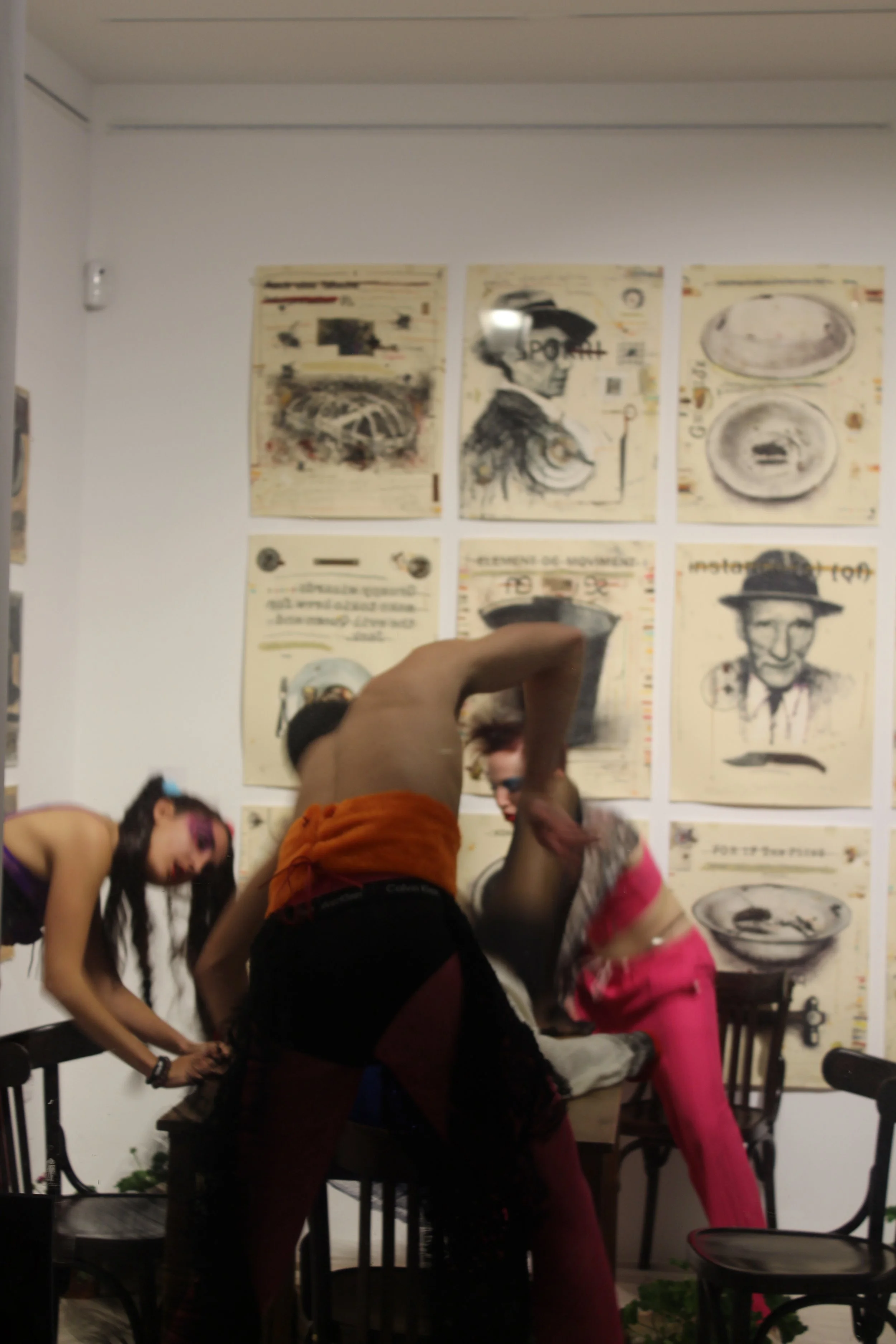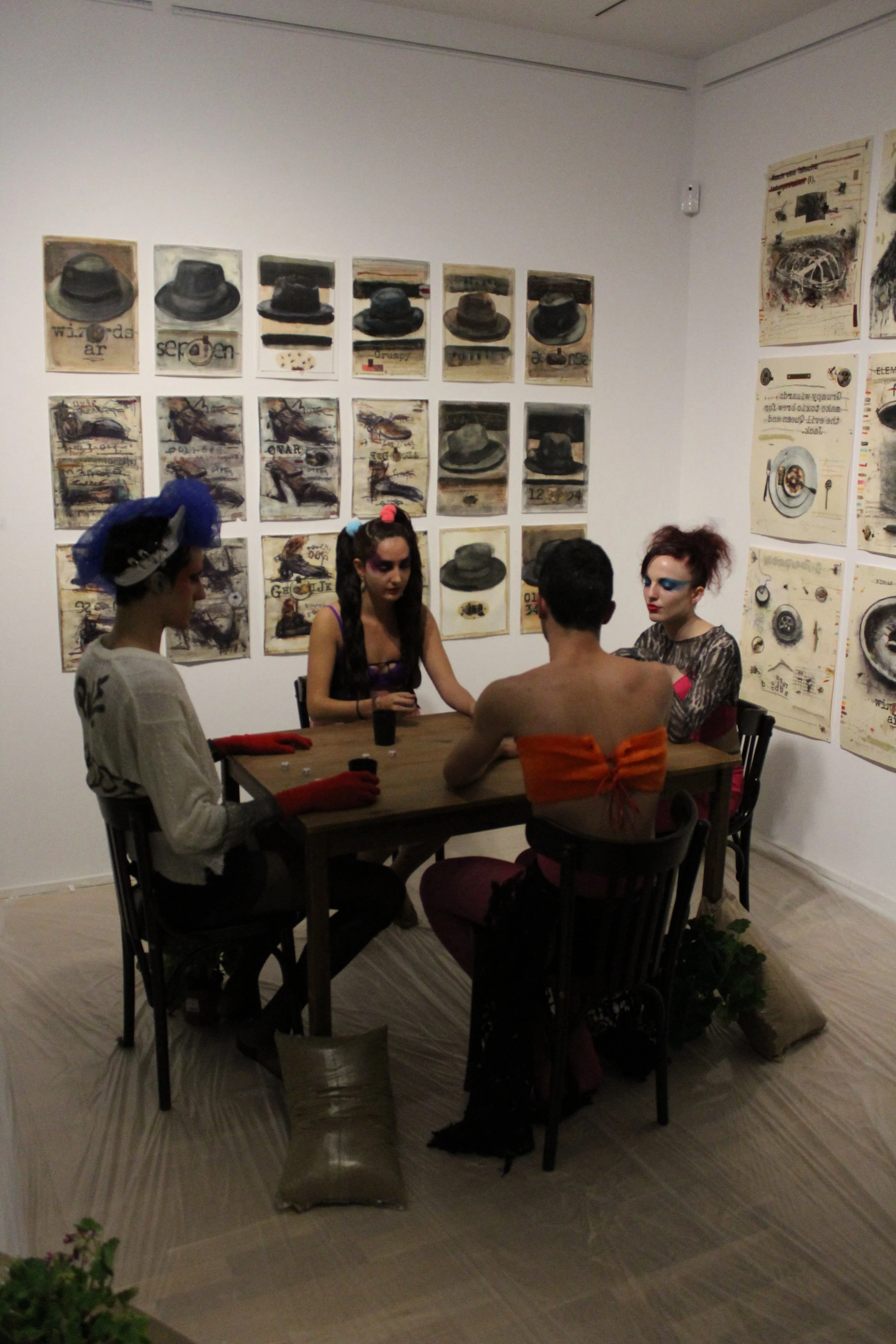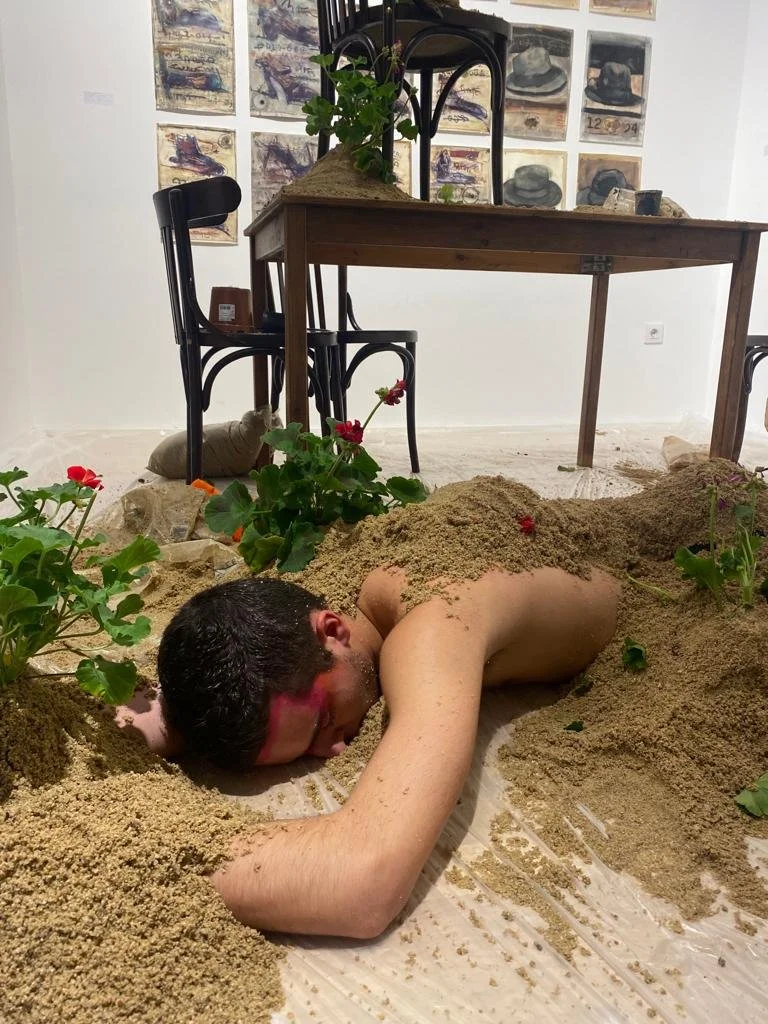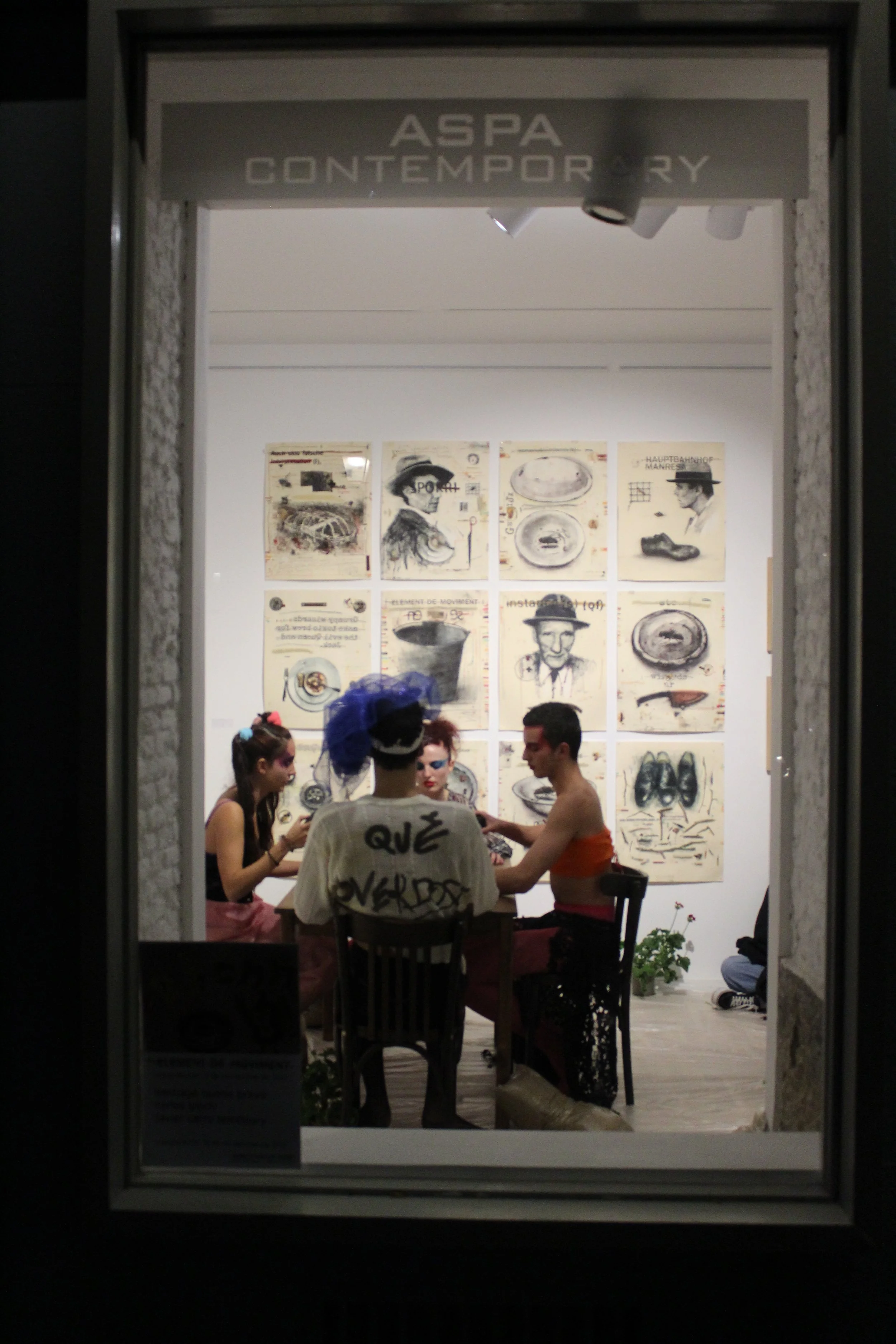POSO- Jimena Tercero (Madrid, 2025)
¿Cómo se inscriben en nosotros las marcas de los afectos, del contacto y de la historia compartida?
La pieza performativa reflexiona sobre el cuerpo como soporte y archivo de experiencias, un territorio donde las relaciones humanas dejan huellas pesadas o posos acumulativos. En esta acción, la artista expone su cuerpo a un proceso de inscripción colectiva, evidenciando su vulnerabilidad como espacio de recepción y transformación. A través de un gesto de acumulación y transferencia, la obra interroga la persistencia de la memoria en el cuerpo y su condición de superficie sensible a lo externo.
En este juego de tensiones entre presencia y ausencia, lo material y lo inmaterial; el amor, el dolor, la gratitud y el arrepentimiento se hace visible a través del color rojo; representando la carga simbólica de las vínculos compartidos y su impacto en la construcción de nosotros mismos.
Texto curado por Daniel Outon.
EN
POSO- Jimena Tercero (Madrid, 2024) How are the marks of affection, contact and shared history inscribed in us? The performative piece reflects on the body as a support and archive of experiences, a territory where human relationships leave heavy traces or cumulative residues. In this action, the artist exposes her body to a process of collective inscription, evidencing its vulnerability as a space of reception and transformation. Through a gesture of accumulation and transfer, the work interrogates the persistence of memory in the body and its condition as a surface sensitive to the external. In this game of tensions between presence and absence, the material and the immaterial; love, pain, gratitude and regret become visible through the color red; representing the symbolic load of shared bonds and their impact on the construction of ourselves.
Text curated by Daniel Outon.






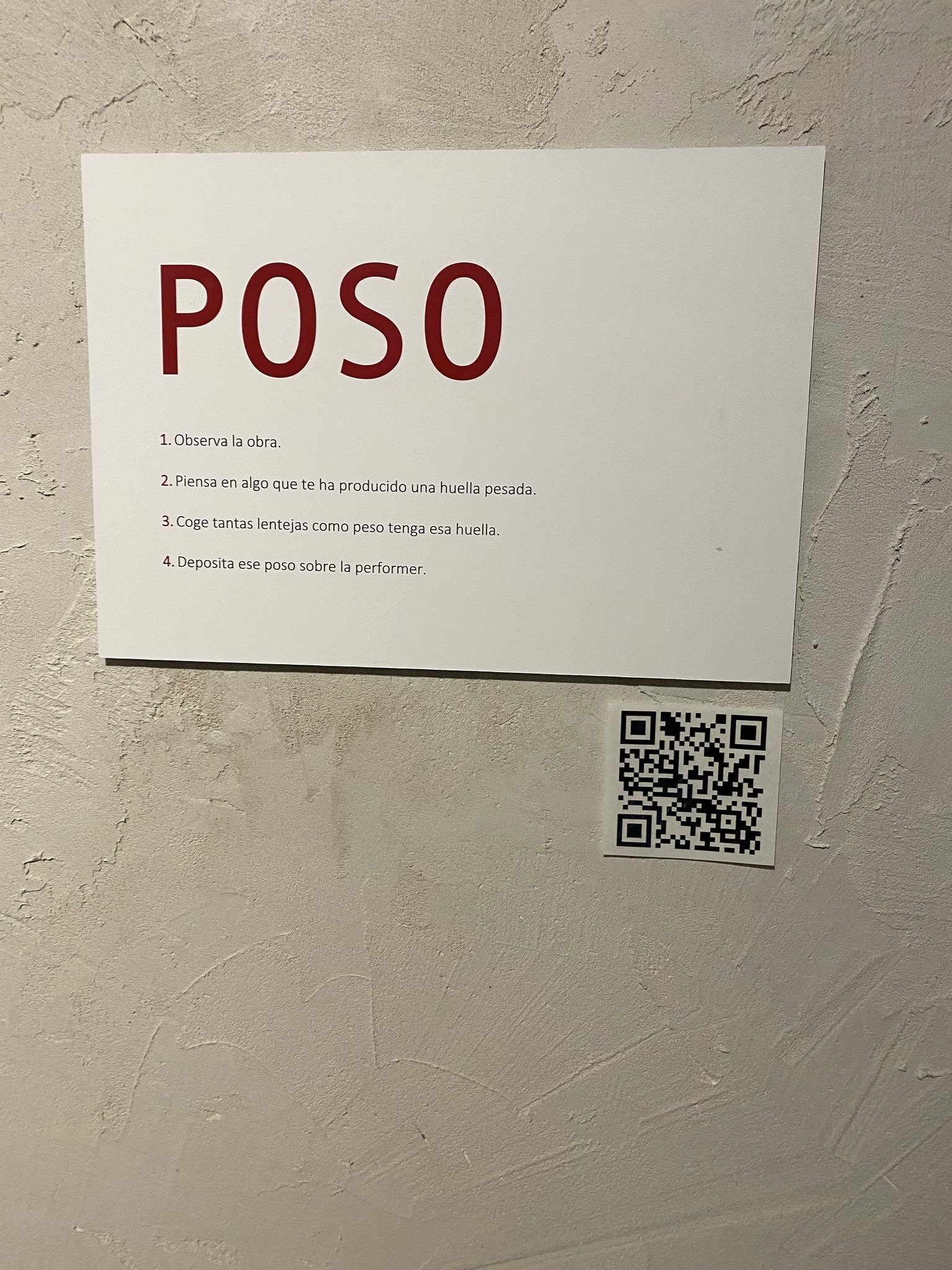



Edén is a performative installation that reinterprets the biblical myth of the creation of Adam and Eve, exploring the relationship of the bodies with the concept of original sin through the symbolic element of the apple.
Jimena Tercero (1998, Madrid) and Adrián Canto (2001, Madrid) began their research in performance and installation by analyzing and interpreting the figures of Adam and Eve to reflect on gender roles and their impact on society. In this piece, the rupture of the dichotomy between male and female bodies resignifies the classic myth. Through various physical actions, the performers engage in a dialogue with the apple, generating a conversation between the Apollonian and the Dionysian, the feminine and the masculine. These first humans, created by God and expelled from paradise, have typically been characterized as antagonistic: Adam representing the traditional traits associated with “masculinity,” and Eve those of “femininity,” with Eve being seen as the sole culprit for their expulsion and the transition from Eden to the world of ordinary beings, where men are condemned to live thereafter.
Edén is divided into eight actions that explore a shift in gender roles and power dynamics. The characteristic features of Adam and Eve are not only reversed but also amplified. Eve adopts more masculine behaviors, thus questioning the traditionally feminine traits associated with her. These changes go beyond a simple role reversal, instead amplifying and stretching traits that already existed in them—traits that were not exclusively masculine or feminine—thereby casting doubt on the classic interpretation of this myth. The courage, initiative, and leadership, which are already present in the foundational myth in the figure of Eve, are emphasized. Eve, who bites the apple, not only avoids reversing gender roles or identity but also deepens the ambiguity surrounding the interpretation of this myth. The performance highlights traits typically associated with masculinity in Eve, whom we see in the Edén of Adrián and Jimena as an Amazon and an archer. Similarly, Adam’s traits are transformed, presenting him as an enraptured character who enjoys the beauty of paradise and embodies traits typically associated with femininity, such as being passive, not participating in decision-making, and bearing the consequences of Eve’s initiative—something counterintuitive in a patriarchal framework.
Edén es una instalación performática que resignifica el mito bíblico de la creación de Adán y Eva,explorando la relación de los cuerpos con el concepto del pecado original a través del elemento simbólico de la manzana.
Jimena Tercero (1998, Madrid) y Adrián Canto (2001, Madrid) inician su investigación en la performance y la instalación, analizando e interpretando las figuras de Adán y Eva para reflexionar sobre los roles de género y su impacto en la sociedad. En esta pieza, la ruptura de la dicotomía entre el cuerpo masculino y el cuerpo femenino resignifica el mito clásico. A través de diferentes acciones físicas, los performers dialogan con la manzana, generando una conversación entre lo apolíneo y lo dionisíaco, lo femenino y lo masculino. Estos primeros humanos creados por Dios, expulsados del paraíso, han sido típicamente caracterizados como antagónicos: Adán, representando las características propias de la “masculinidad”, y Eva, las de la “feminidad”, siendo Eva vista como la culpable exclusiva de la expulsión y del traslado del Edén al mundo de los seres ordinarios, donde a partir de entonces están condenados a vivir los hombres.
Edén se divide en ocho acciones que exploran un cambio de roles de género y relaciones de poder. Los rasgos característicos de Adán y Eva no solo se revierten, sino que se amplifican. Eva asume comportamientos más masculinos, cuestionando así los rasgos femeninos con los que tradicionalmente se la ha asociado. Estos cambios no se limitan a una simple inversión de roles, sino que amplifican y estiran las características que ya existían en ellos, rasgos que no eran
exclusivamente masculinos o femeninos, sembrando así la duda sobre la interpretación clásica de este mito. La valentía, la iniciativa y el liderazgo, que ya se observan en el mito fundacional en la figura de Eva, se potencian. Eva, que prueba la manzana, no solo no invierte los roles de género o identidad, sino que amplía la duda sobre la interpretación de este mito. La performance resalta los rasgos típicamente asociados a la masculinidad en Eva, a quien vemos en el Edén de Adrián y Jimena como una amazona, tiradora con arco. De manera similar, los rasgos de Adán se transforman, presentándolo como un personaje embelesado que disfruta de la belleza del paraíso y reproduce rasgos típicamente asociados a la feminidad, como un ser pasivo que no participa enla toma de decisiones y que no impone su voluntad si no que carga con las consecuencias de la iniciativa de Eva, algo contraintuitivo en un esquema patriarcal.
Text written by Teresa Lafuente, Art Historian
White Lab Gallery, Madrid (2024)







NAVEL BITE
Esta performance cuestiona el dialogo que mantenemos actualmente los humanos a traves de la identidad que generamos con los teléfonos móviles.
Mediante la interacción de los espectadores con el cuerpo de la performer se utilizan los aparatos technologicos que lleva en el cuerpo a modo de camara fotografica- selfie, donde el espectador interactua y se fotografia. Estas imágenes pasan a ser el archivo que ha sucedido en este espacio-tiempo.
Por lo tanto la performer materializa el dialogo que establece el espectador para verse “ asi mismo” y fotografiar su propia imagen.
A su vez la performer lleva un telefono que le acompaña mirandose a “ella misma” en streaming donde no separa la mirada de sus espectadores de “instagram”. Acentuando asi esta individualizacion del sujeto y la relacion con su imagen.
EN
This performance questions the dialogue that humans currently maintain through the identity we generate with mobile phones.
Through the interaction of the spectators with the body of the performer, the technological devices that she carries on her body are used as a selfie camera, where the spectator interacts and atv the same time is photographed. These images become the archive of what has happened in this space-time.
Therefore, the performer materializes the dialogue established by the viewer to see “himself” and photograph her own image.
At the same time, the performer carries a phone that accompanies her while watching “herself” in streaming where she does not separate her gaze from her “Instagram” viewers. Thus accentuating this individualization of the subject and the relationship with her image.
AT Sinespacio Gallery, 2024.
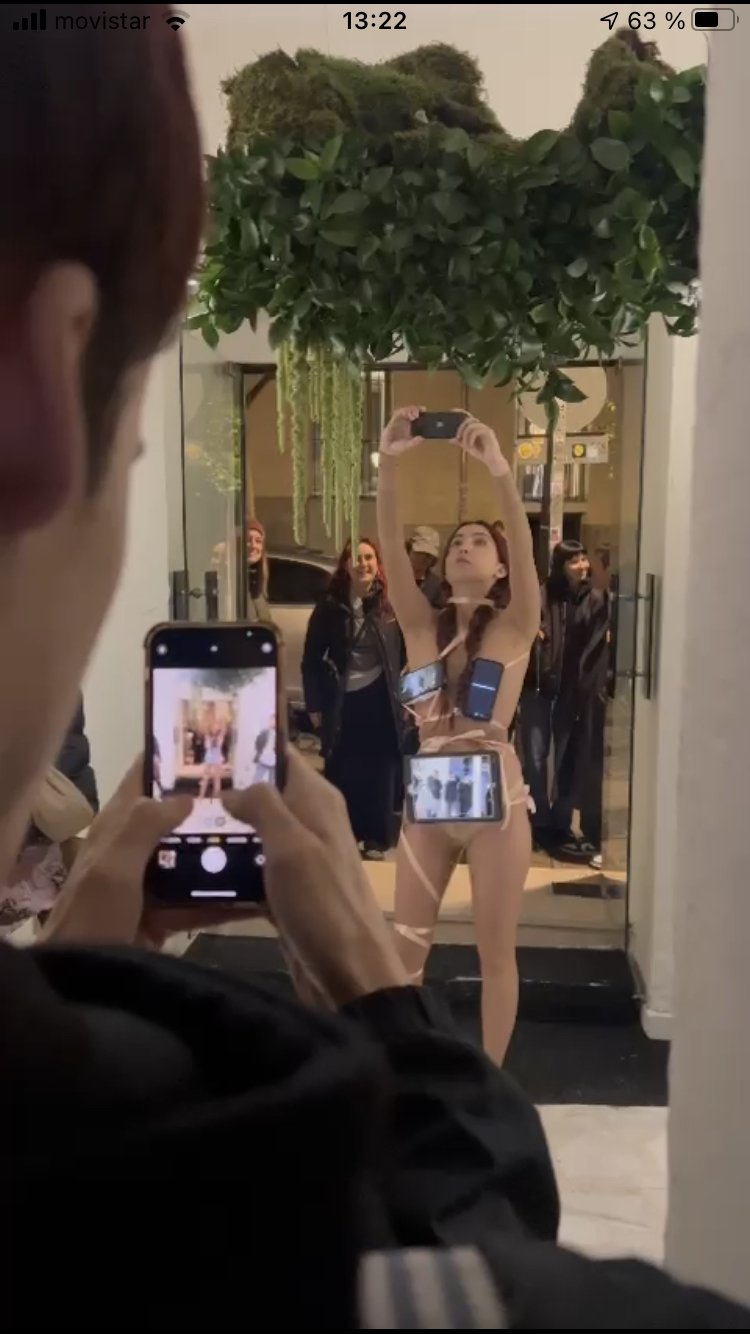







¿Qué haces?
ARCO 2024, Madrid
¿Qué haces?
“YO MI ME CONMIGO”
Performance que reflexiona sobre el dialogo interno con nosotros mismos. A traves del elemento del “cabello”, la artista sugiere una danza y una serie de movimientos fisicos donde a traves de este ente abstracto resalta el concepto de “ intimidad”.
EN
Performance that reflects on the internal dialogue with ourselves. Using the element of “hair”, the artist suggests a dance and a series of physical movements where, through this abstract entity, she highlights the concept of “intimacy”.
At Teatros del Canal 2022, Madrid.
¿Qué haces?
“INSTANTES PERDIDOS”
Instantes Suspendidos es una pieza performática que invita a reflexionar sobre los fragmentos de tiempo que se escapan en la vorágine de la vida cotidiana. Inspirada en la obra de Carlos Bloch y su exploración de la memoria visual en la “Movida Madrileña” de los años 80, esta performance traslada esa mirada al presente, marcado por la omnipresencia de la tecnología y el acto constante de capturar imágenes a través de los teléfonos móviles.
En esta propuesta, el objeto escénico central son los paraguas de foto-estudio, que actúan como símbolos sonoros y visuales del instante congelado en la fotografía. Mientras la tecnología intenta inmortalizar momentos, la acción escénica evidencia lo que se pierde en el proceso: aquellos sucesos efímeros que ocurren justo fuera del marco de nuestra atención.
La performance se desarrolla en varios actos que descomponen el tiempo en fragmentos sensibles, invitando al espectador a cuestionar su relación con el presente, la memoria y la percepción del instante. A través del diálogo entre sonido, espacio y cuerpo, Instantes Suspendidos propone un viaje poético hacia la experiencia del tiempo detenido y la importancia de lo intangible.
EN
Suspended Moments is a performative piece that invites reflection on the fragments of time that slip away in the whirlwind of everyday life. Inspired by the work of Carlos Bloch and his exploration of visual memory during the “Movida Madrileña” of the 1980s, this performance brings that gaze into the present, marked by the omnipresence of technology and the constant act of capturing images through mobile phones.
In this piece, the central stage object is photographic studio umbrellas, which act as both sonic and visual symbols of the frozen moment in photography. While technology attempts to immortalize moments, the performance reveals what is lost in the process: those fleeting events occurring just beyond the frame of our attention.
The performance unfolds in several acts that break down time into sensitive fragments, inviting the audience to question their relationship with the present, memory, and the perception of the instant. Through the dialogue between sound, space, and body, Suspended Moments offers a poetic journey into the experience of suspended time and the significance of the intangible.
At ASPA CONTEMPORARY GALLERY 2022, Madrid.
¿Qué haces?
“LAST”
Esta performance replantea la “ Ultima Cena” desde el punto de vista de una mujer. La artista cuestiona donde emerge el papel de la mujer dentro de las historias biblicas y como se le otorga una figura de “pecado”.
EN
This performance rethinks “The Last Supper” from a woman's point of view. The artist questions where the role of women emerges within biblical stories and how she is given a figure of “sin.”
At La Juan Gallery 2023, Madrid.
¿Qué haces?
“INSIDE VOICE”
ESP
Esta performance habla de aquellas voces abstractas que emergen dentro de nosotros.
El “pequeño monstruo” que nos habita a veces hay que domarlo o sacarlo a pasear.
EN
This performance speaks out of those abstract voices that emerge within us. The “little monster” that lives in us sometimes has to be tamed or taken out for a walk.
Conde Duque 2021, asesorada por Itziar Okariz.





